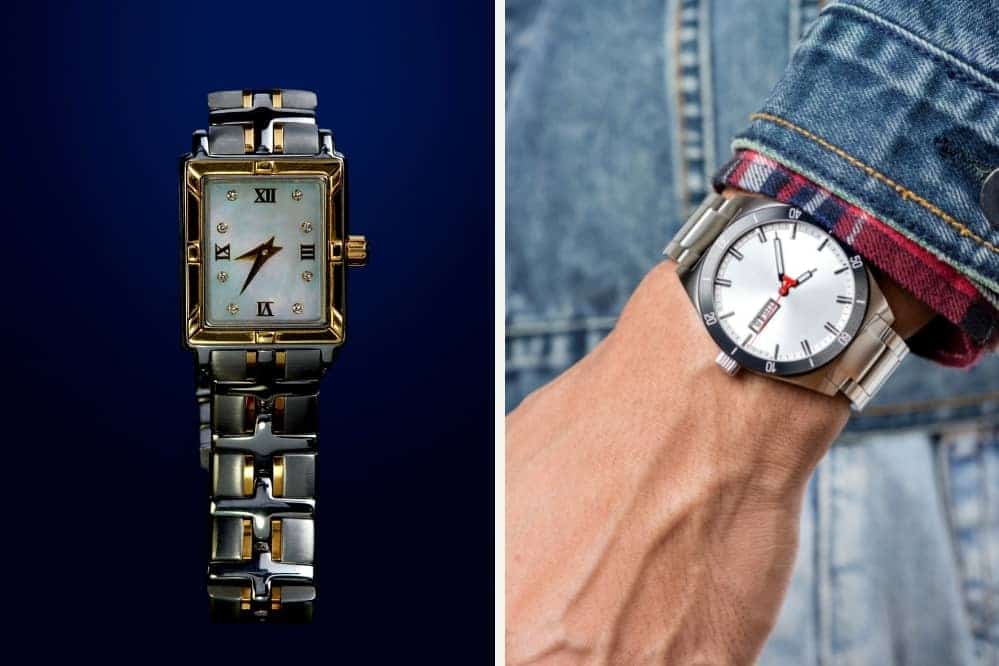Many a time, for a first-time or inexperienced watch buyer, the differences in men’s vs. women’s watches may be too subtle to notice. You certainly don’t see friends or family going around (we hope!) staring at people’s wrists figuring out whether it comes from the men’s or the women’s section. However, qualities and designs often differ by gender, so if you want to be wearing a watch well-suited to yours, read on.
Five Main Differences Between Men’s and Women’s Watches
1. Size of the Wrist
Some men’s watches fit every single category of visual appeal, yet a watch slipping down your wrist to your fingertips comes with a plethora of problems. It can snag people’s bags and earn you dirty looks; you can lose your brand-new watch and the money you spend on it. Watches curated for smaller wrists are usually geared toward women, and roomier ones for men.
If you feel that the watches on display for you are too small or too large, or do not agree with the whole concept of men’s vs. women’s watches when a design has caught your eye, you can request for a custom one.
2. Strap Width
This is the one main give-away to bank on while purchasing a watch for your gender. Women’s watches are universally made with slimmer watch straps. Men’s watch straps are thicker and wider in comparison. While some women’s watches can have thicker straps, for men’s watches to have thinner straps is highly unlikely.
3. Design and Features
Manufacturers create watches with distinct differences when it comes to design and style. With women’s watches, finding a plethora of possibilities for dial style, color, adornments, and features is common. Men’s watches are usually simpler, with color patterns usually in navy, black, silver, beige, and muted gold.
The watches usually give a clean-cut and organic impression. Women’s watches come adorned with precious gems such as diamonds, though men’s watches can be customized to add gems and adornments and look flashy. Women’s watches in red, pink, deep gold, lavender are created with finesse and delicacy. Some more muted, simpler watches can be misleading, so be on the lookout for those as well.
4. Circumference of the Dial
Larger dials are usually fitted on watches intended for male buyers. While this may not be a marked difference in men’s vs. women’s watches, it is common to see a smaller dial on women’s watches to coincide with the thinner straps. After all, a humongous dial with a skinny strap can look rather odd. Don’t worry too much about this difference, though, as what’s important is that the dial tells the correct time.
5. Strap Materials
Higher quality, leather watches may very well indicate a watch for both genders, which is the same with good quality metal. Smart watches intended for both genders come in the same plastic or leather straps for both genders. There is, however, more variety such as stretch ability and compactness around the wrist through materials such as certain plastics that are more commonly seen with women’s sport watches.
Honorable Mention: Functionality and Features
Across the board, men’s watches have larger dials and within those dials, there are much more features added. Stopwatch and calendar features are all too common in conventional watches created for men. Men’s watches have larger dials and that means all the more features and flashiness. Since the watches are chunky, they tend to catch the light and draw attention. Women’s watches are more delicate, but can have a lot of bling if the wearer chooses.
If certain features are only prevalent in watches of a certain gender, knowing where to look can be a great help. There are many variations and options with both men’s and women’s watches. If gender isn’t a factor for you but merely style, the whole men’s vs. women’s watches debacle can be ignored while you go watch-shopping.
